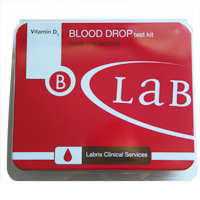Vitamin D – Are You Getting Enough?
|
Labrix Vitamin D Blood Spot Test – Click here to purchase |
When it comes to your health, the topic of vitamins and supplements often comes to mind and none is hotter these days than Vitamin D.
Research at the University of Calgary in Canada suggests that over 95% of Canadians are vitamin D deficient at some point in the year. Worldwide, an estimated 1 billion people may not get enough. Chances are if you live in a Northern Climate that you aren’t getting enough Vitamin D . And this is especially true in the winter when the sun’s UVB rays just aren’t strong enough for us to manufacture any Vitamin D. The only way to know for certain is to test your levels of 25-hydroxy-vitamin D (25(OH)D), which is the circulating form of vitamin D and routinely used to diagnose vitamin D deficiency. Many clinicians recommend that you test annually to ensure that you maintain optimal levels. Click here to purchase ourLabrix Vitamin D Test Kit. And, read on about why optimal Vitamin D levels are essential to good health. *Due to State regulations we are unable to process orders for residents in California or New York. |
What is Vitamin D?
Also known as the “sunshine vitamin”, vitamin D isn’t really a vitamin, but a key regulatory hormone for calcium and bone metabolism. We’ve known for a long time that adequate vitamin D is essential for ensuring normal calcium absorption and maintenance of healthy calcium plasma levels.
Recent research suggests that adequate blood levels of Vitamin D may be necessary
to prevent or reduce the incidence of cancer, cardiovascular disease, diabetes, and
immunity. And while some organizations have issued recommendations regarding daily
requirements, others in the US and Canada are reviewing available evidence prior to
making statements regarding Vitamin D’s role in these health conditions.
Doesn’t My Body Produce Enough of its Own Vitamin D?
Some research has shown that if you’re exposing your arms and legs to the sun for 5 to 10 minutes, you’re making 3000 to 5000 IUs of vitamin D. If you’re a sunscreen user or spend the winter (October to March) in many parts of North America and Northern Europe, you probably aren’t exposed to adequate amounts of UVB rays to manufacture any vitamin D.
You can get vitamin D from fortified milk and oily fish such as salmon and sardines, but food alone won’t provide enough. For this reason you may want to consider supplementing.
Vitamin D Guidelines
Guidelines for supplementing with Vitamin D varies amongst organizations. The only way to know for certain if your levels are adequate are to check for levels of 25-hydroxy-vitamin D (25(OH)D) using a kit like the Labrix Blood Spot Test:
- Osteoporosis Canada recommends daily supplements of:
- 400 to 1,000 IU for adults under age 50 without osteoporosis or conditions affecting vitamin D absorption.
- 800 to 2,000 IU for adults over 50. 2.
- The Canadian Cancer Society recommends Canadians take in 1,000 IU every day.
During the spring and summer, that can be accomplished through normal daily exposure to the sun. In the fall and winter months, a vitamin D supplement may be necessary.
- Health Canada’s guidelines remain at 400 IU.
Health Canada advises people to take a daily vitamin D supplement, as following the revised Canada Food Guide would only provide 200 IU of vitamin D a day. Health Canada has set the upper limit at 2000 I.U.s per day.
If you are elderly, darker skinned or spend little time in the sun, you are probably a candidate for increased dosing. Studies and investigations continue so it is likely that recommendations will be revised. These guidelines are based on information available November, 2010. Note that some practitioners advocate higher doses, but always clear doses above those recommended above with your physician first.
To ensure that your Vitamin D levels are adequate and that you aren’t overdosing by supplementing, test for 25-hydroxy-vitamin-d (25 (OH)D) to ensure that levels are within the ideal range. It’s recommended that you test after supplementing for 2 to 3 months in order to get your blood levels of Vitamin D up. You may want to repeat this test annually to ensure your levels remain within range.
What Kind Of Vitamin D?
Because I am dark skinned and live in Canada, I supplement year round with Thorne Vitamin D Drops (I like the convenience of taking one less capsule – it is also available in combination with Vitamin K – check with your physician if this option is suitable for you). I do enjoy the sun in the summer, so I adjust based on testing.
If you’re going to supplement look for either drops or oil capsules that contain vitamin D3 (cholecalciferol), which is the same form of Vitamin D that your body produces when exposed to sunlight. Vitamin D2 (ergocalciferol) is not the same. Tablets are usually not a good way to get your Vitamin D.




